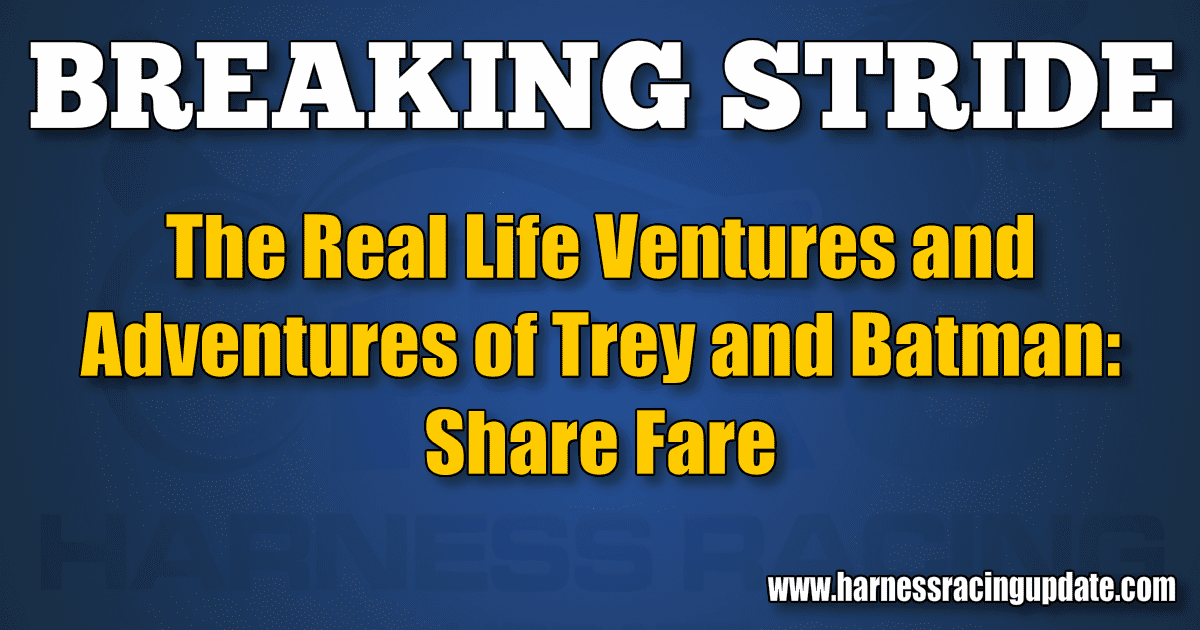

Share Fare
The Real Life Ventures and Adventures of Trey and Batman
by Trey Nosrac
“I’m slightly miffed.”
We sat in a booth at a hole in the wall vegan restaurant named Kale Me Krazy on East Ninth Street. My new harness horse racing recruit looked up from his Half Tofunafish Sandwich and Kale Salad Special. He asked, “What are you miffed at?”
“Something on Facebook.”
“You told me you don’t use Facebook.”
“I said I don’t POST on Facebook; I just lurk for a few minutes with my morning coffee. Today I spotted a few lines about the Guru, a fellow who writes an interesting column for HRU. He doesn’t just write about harness racing; he also offers commentary on many topics.”
“So?” he asked.
“Someone in the thread whined about the low number of likes and forwards on a recent column of his. That’s not his fault, it’s the fault of the readers. The Guru could be F. Scott Fitzgerald, he could post The Great Gatsby, and not get much liking or forwarding.”
My friend pushed around a piece of kale with his chopstick as he looked up and said, “In my years working in Silicon Valley, we spent every day on this topic – social content, how to get certain material forwarded. We called it supplying the pushers. There are oceans of data as to what type of people share what type of information. Not as many people share as is believed.”
With a dismissive wave of his chopstick, he gave a frustrated sigh, “The whole subject is crazily complicated with variants and psychology.”
“Well, Mister Silicon Valley, your reply suggests that I can’t keep up with your brilliance. Now I’m twice miffed.”
He snorted a laugh, and pointed his chopstick at me, “You are part of a large segment that suffers from Visio bibliophobia, a fear of social media. Many people have a touch of this and some researchers refer to this fear as prosopobibliophobia.”
“Now you’re just messing with me. I have no phobias, that makes me an antiphobiac. And put down that chopstick so nobody gets hurt. ”
He grinned and slipped into professor mode, “A large percentage of harness horse participants grew up before the Internet. They didn’t grow up with phones glued to their heads. This type of audience has a bias against posting. They are very good about reading and absorbing information digitally, but they are not nearly as prolific at sharing.”
I nodded in agreement, “I never post anything unless it has a stamp. My first thought isn’t always great, usually in the range between smart ass and dumb ass. If I want a stupid remark on my permanent record and if I want to bicker, I could get remarried. I don’t do Facebook, tweet, or any of the fifty different free and fast ways to make a fool of myself – I like to do it slowly.”
He continued as Professor Batman, “Of course there are outliers, but members of the racing community are not teenagers keeping up with Arianna Grande. Social media is still a bit uncomfortable for many people. They have a fear of starting something they can’t keep up with, a fear of rejection, and they have a level of discomfort with arguments. We used a variant called the 1-9-90 Rule. This is a rule of thumb about people who share user-generated content – one per cent are power users, nine per cent are occasional contributors, and 90 per cent just lurk.”
He finished with a flurry, “So accordingly, 90 per cent to 99 per cent of any community, like horse racing, are lurking in the shadows, passively standing by, and watching as a small active minority engage with one another.”
“So let me ask you this, what sort of stuff gets shared on the Internet?”
“We have known that answer for a long time, status and emotion. These forces drive digital and social sharing.”
“Status?”
“Sure, if I share a book, an article, a story, a column, or a joke with you, it boosts my status. It’s sort of like bragging that I know this and now I’m sharing it with you.”
“Emotion?”
“Yes, and this does not just mean you love something like harness racing. Sharing is tricky. Just because you love a sport doesn’t necessarily lead to sharing it.”
“Besides posts of cats, what sort of posts break through the clutter and get shared?” I asked.
He set down his chopstick next to his plate and leaned back, “A story about a struggling waitress getting stiffed on her tip can set off wild social sharing. A post like this stirs up angry emotions, and the person who shares the story is attempting to improve their status by implying they always tip.”
I thought about this for a few seconds and gave a thoughtful reply, “Huh.”
He added, “If the waitress got a $10,000 tip, it could do the same thing because positive emotion can drive sharing. Stories, articles, photos, jokes, sounds, anything that touches one end of the positive or negative emotion spectrum are the best bets.”
I said, “So The Guru can write about races, breeding, or harness racing sires until the cows come home and he’s not going to get much sharing or liking.”
He shook his head, “His audience is not filled with hyper sharers. Informational content is limited. He needs to put up content that tugs at our heartstrings, make readers fall on the floor laughing, be very unusual, or causes great outrage – anything that falls between gets lost. And then there is another level of sharing that is even more complex.”
“Go ahead Batman, I can take it.”
“What platform you decide to share content on is dependent on what type of person you are or what type of content you are sharing. Facebook is far from the only choice on social media, and the options for social posting are staggering. Smaller, more exclusive sites that most people have never heard of are trending. Whether you are an altruist, a careerist, a hipster, an attention seeker, a connector, or you are into a small niche – these days, every person has a place to share and those places multiply like rabbits.”
I sighed, “Everyone says harness racing needs to get into the social media world to grow.”
“This is true, but also very difficult. Shares, likes, links, they are often false barometers. One share that reaches a billionaire who gets enthused about your sport because of something funny or quirky can be more powerful and productive than a million shares that are unproductive.”
“So what is the moral of this story?”
“Keep sharing, step out of the shadows if you find content that might help grow the sport, share smart, share outside the racing choir, and hope that a smidgen of engaging content lands on the eyeballs of a Jeff Bezos and he leaves a billion-dollar tip for an altruistic harness horse trainer.”















